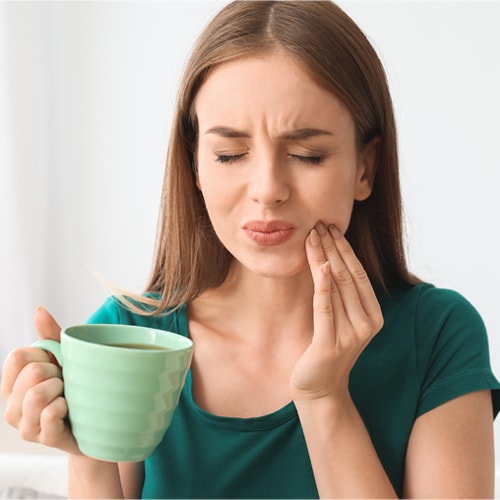Dentin hypersensitivity is one of the most common oral health complaints. However, because many patients do not mention their symptoms during routine visits, it can also be one of the more challenging conditions for a dentist to evaluate and diagnose. In this article, we’ll discuss how dentists can recognize dentin hypersensitivity in their patients and provide effective, holistic treatment.
What is dentin hypersensitivity?
Dentin hypersensitivity is a short, sharp pain arising from exposed dentin in response to non-noxious stimuli, that cannot be attributed to any other oral defects or diseases.
Patients with dentin hypersensitivity feel pain when they’re exposed to a stimulus that wouldn’t ordinarily be expected to cause such a response. Hot or cold foods and drinks, gentle touch or pressure, acidic or sweet foods/drinks, and even air flowing past the tooth can trigger pain.
What causes dentin hypersensitivity?
Despite it being a very common dental problem, the etiology of dentin hypersensitivity is still not fully understood. The most-accepted explanation relates to movement of fluid inside the dentinal tubules.
When dentin is exposed and the tubules are open, an external stimulus as described above causes movement of the tubular fluid which is thought to stimulate pulpal nerves that terminate in the tubules. This leads to individuals experiencing the characteristic short, sharp pain of dentin hypersensitivity.
What causes the exposure of dentin?
There are a number of factors that can lead to dentin exposure. These include:
- Gingival recession
- Periodontal tissue loss due to periodontitis
- Dental attrition, or tooth wear, due to ageing or bruxism
- Dental erosion
- Dental caries
- Abrasion from over-zealous toothbrushing or parafunctional habits.
How common is dentin hypersensitivity?
While it’s difficult to establish the prevalence of dentin hypersensitivity, based on most reviews it is estimated that up to 57% of people are affected.
Many patients cope by simply avoiding their pain triggers, like ice cream or hot coffee. However, as dentin hypersensitivity becomes more severe, the patient may find it painful to do everyday actions like speaking, eating, drinking or brushing their teeth. Obviously, this can be disruptive to their daily lives and harmful to their wellbeing.
Still, patients will often take “sensitive teeth” in their stride and neglect to mention it during routine dental visits. They may believe that some degree of pain is normal, or that they’re coping just fine. For that reason, many cases go unnoticed.
How is dentin hypersensitivity diagnosed?
As patients so often fail to mention dentin hypersensitivity, you should take the initiative and proactively ask your patients if they experience symptoms.
Dentin hypersensitivity is a diagnosis of exclusion, which means that it’s only diagnosed when other possible causes of pain are ruled out. To do this, you would first conduct a clinical and radiographic exam to rule out causes such as dental caries, recent restorative care, cracked teeth, other defects or injuries.
Next, assess your patient for etiological risk factors like gingival recession or dental erosion, and ask them some questions about their pain.
- Is it short and sharp?
- Does it come on spontaneously?
- Does it happen after certain foods, drinks, or actions?
- How long does it last?
- What makes the pain subside?
If your patient’s pain is typical of dentin hypersensitivity – short and sharp, spontaneous, with identifiable triggers – and doesn’t appear to have an underlying clinical cause, then dentin hypersensitivity is the likely diagnosis, particularly where etiological risk factors are present.
How to help patients with dentin hypersensitivity
To help your patients find lasting relief from dentin hypersensitivity, recommend a soft-bristled toothbrush and prescribe a desensitizing toothpaste to use at home.
Of course, treating dentin hypersensitivity requires a holistic approach that goes beyond simply relieving the pain. You should also recommend lifestyle changes to your patients where necessary, such as minimizing acidic foods, avoiding soda or sports drinks and modifying brushing technique.
If bruxism is a possible cause, the use of a night guard can be recommended to prevent further attrition. Note that bruxism can often be attributed to stress – something your patients might be experiencing much more of during the COVID-19 pandemic – so you can also recommend mindfulness techniques, or signpost further support for your stressed patients.
Many of our patients simply accept dentin hypersensitivity as a fact of life, but we can help them find relief – if we know about it! Don’t leave it up to your patients to talk about dentin hypersensitivity. By taking the proactive and holistic approach, we can start helping them to improve their quality of life right now.

